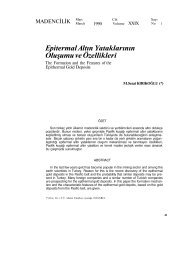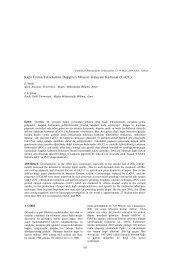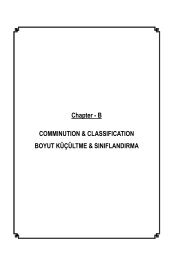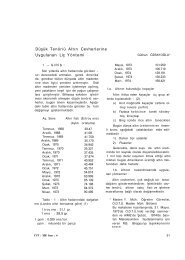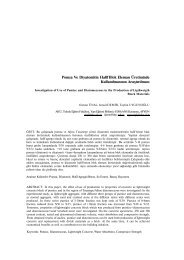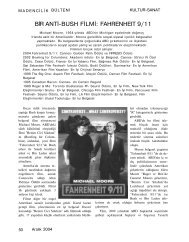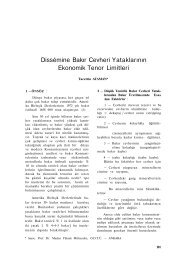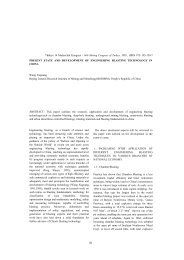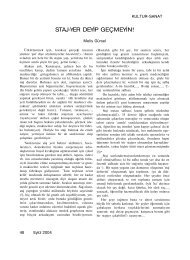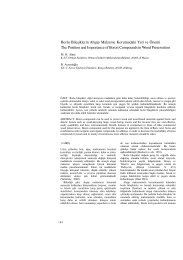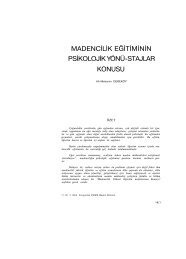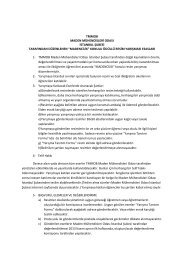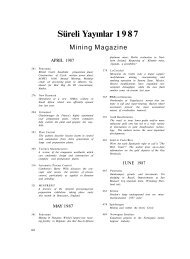A OPEN PIT MINING AÇIK OCAK MADENCİLİĞİ
A OPEN PIT MINING AÇIK OCAK MADENCİLİĞİ
A OPEN PIT MINING AÇIK OCAK MADENCİLİĞİ
You also want an ePaper? Increase the reach of your titles
YUMPU automatically turns print PDFs into web optimized ePapers that Google loves.
23 rd <br />
shape and depth of deposit, mine production<br />
schedule, geology, material characteristics,<br />
blasting performance, climate, environment,<br />
capital cost, operating cost, maintenance,<br />
support, power costs versus fuel costs,<br />
reliability, useful life, haul distance, operator<br />
requirement, life of mine, hardness and<br />
abrasiveness of material.<br />
The mentioned above parameters are used<br />
by different researcher to selecting the<br />
proper mining haulage system, but by<br />
considering the sustainable development<br />
concept, it seems that there are some other<br />
factors such as greenhouse gas emission,<br />
accident probability, ground vibration, dust<br />
production, land degradation, Number of<br />
employment and reclamation requirement,<br />
that can be considered in equipment<br />
selection.<br />
By taking into account the fact that, the<br />
mining production had an increasing trend<br />
through the years and average grade of<br />
produced ore was decreasing in the same<br />
years. This means that, high-grade ores are<br />
consumed and in order to produce a known<br />
amount of metal from a low-grade ore, one<br />
has to exploit a large volume of materials.<br />
So, so-called easy mineral deposits have<br />
been mined therefore, one could conclude<br />
that, the mine size must be enlarged, and<br />
here comes the time for Giant Mining<br />
(Osanloo, 2012), the size of mining<br />
equipment will grow to achieve required<br />
production rate and it means more fuel<br />
consumption, labour requirement, road<br />
construction and as a result, more<br />
environmental impact in mining activity.<br />
Therefore, it is important to have a long-term<br />
vision in equipment selection. Paying<br />
attention to SD concept, the effective<br />
parameters in mining equipment selection<br />
can be divided in to four groups, technical,<br />
economic, social and environmental. The<br />
technical criteria are essential factors in<br />
engineering works and in order to<br />
considering SD concept the parameters that<br />
are related to environmental, social and<br />
economic added to decision making criteria.<br />
The criteria for each group are as below:<br />
Technical; production, geology, deposit<br />
depth, haul distance, mine life, equipment<br />
installation time. Environmental; climate,<br />
greenhouse gas emission, dust production,<br />
land degradation, reclamation requirement.<br />
Social; ground vibration, accident<br />
probability, No. of employment. Economic;<br />
operating and capital cost, power costs, fuel<br />
cost, labour cost, maintenance cost,<br />
reliability.<br />
5 PREFERENCE VOTING SYSTEM<br />
In preference voting systems (PVS), each<br />
voter selects m candidates from among n<br />
<br />
most to the least preferred. Each candidate<br />
may receive some votes in different ranking<br />
places. The total score of each candidate is<br />
the weighted sum of the votes he/she<br />
receives in different places (Wang et al.,<br />
2007) that is defined as follow:<br />
z<br />
i<br />
m<br />
<br />
v w<br />
j 1 ij<br />
j<br />
i 1,...,<br />
n.<br />
(1)<br />
Let w j be the importance weight of j th<br />
ranking place (j = 1... m) and v ij be the vote<br />
of candidate i being ranked in the j th place.<br />
The structure of PVS is shown in Table 1.<br />
In this structure, the winner is the one<br />
with the highest total score. Therefore, the<br />
key issue of the preference aggregation in a<br />
PVS is how to determine the weights<br />
associated with different ranking places (i.e.<br />
(w j )).<br />
Broda-Kendall (BK) method (Cook &<br />
Kress, 1990) is a well-known approach to<br />
identify the weights.<br />
This approach assigns weights m, m–1,<br />
m–2,..., 1 to m ranking places, from the<br />
highest ranking place to the lowest<br />
respectively. These weights are produced in<br />
a simple way, but their production process is<br />
quite subjective. To reduce subjectivity in<br />
generating weights, Cook and Kress (1990)<br />
proposed the application of Data<br />
Envelopment Analysis (DEA) in this<br />
problem, which considered candidates as<br />
Decision Making Units (DMUs). Their<br />
proposed model calculates weights for each<br />
candidate that maximizes its total score.<br />
Thereafter, the model is solved once for<br />
each candidate and the total score is<br />
computed.<br />
133



